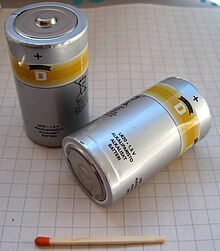
Back Элемент D Byelorussian Mono (Batterie) German باتری دی Persian Baterai D ID Pilha D Portuguese Элемент D Russian D-batteri Swedish D pil Turkish Батарейка D Ukrainian 1号电池 Chinese

A D battery (D cell or IEC R20) is a standardized size of a dry cell. A D cell is cylindrical with an electrical contact at each end; the positive end has a nub or bump. D cells are typically used in high current drain applications, such as in large flashlights, radio receivers, and transmitters, and other devices that require an extended running time. A D cell may be either rechargeable or non-rechargeable. Its terminal voltage and capacity depend upon its cell chemistry.
The National Carbon Company introduced the first D cell in 1898. Before smaller cells became more common, D cells were widely known as flashlight batteries. The U.S. military designation for this battery has been BA-30 since sometime before World War II.[1] During World War II, it was designated the Type C battery by the U.S. Navy, leading to confusion with the smaller C cell battery (BA-42).
In 2007, D batteries accounted for 8% of alkaline primary battery sales (numerically) in the U.S. In 2008, Swiss purchases of D batteries amounted to 3.4% of primary and 1.4% of secondary (rechargeable) sales.[2][3]

- ^ "U.S. Army Flashlight".
- ^ Life Cycle Impacts of Alkaline Batteries with a Focus on End-of-Life - EPBA-EU Archived 7 October 2011 at the Wayback Machine
- ^ "Absatzzahlen 2008" (PDF). Archived from the original (PDF) on 25 March 2012. Retrieved 25 March 2012. INOBAT 2008 statistics.